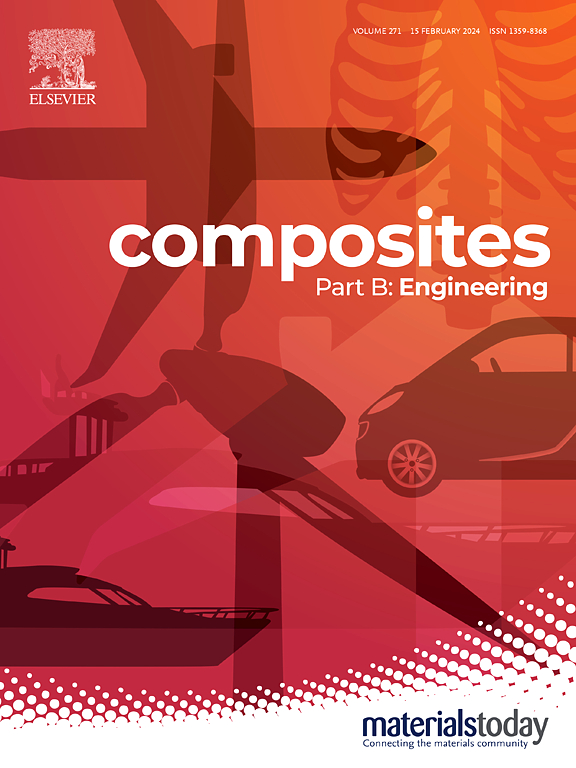Harnessing mussel-inspired phenolic-iron complexes for strengthening carbon fiber reinforced polymer composite interfaces
IF 12.7
1区 材料科学
Q1 ENGINEERING, MULTIDISCIPLINARY
引用次数: 0
Abstract
Carbon fiber reinforced polymer composites (CFRPs) offer exceptional specific strength and lightweight characteristics due to the high-performance nature of carbon fiber. However, carbon fiber's chemical inertness results in weak interactions with the polymer matrix, which hinders the overall performance of the composites. Improving the interfacial properties has been a longstanding challenge in CFRPs development. Introducing nanomaterials along with chemical agents at the interface can enhance both physical and chemical interactions, facilitating better load transfer and more uniform stress distribution. Despite this, surface modification remains a complex process, and the lack of anchor bonds limits the effectiveness of chemical interactions. In this work, inspired by the crack-resistance mechanism of byssal cuticle through metal coordination bonds, we introduce a metal-phenolic network comprising ferric iron (Fe3+) and tannic acid (TA) onto the carbon fiber surface using a simple one-pot deposition method. This approach significantly enhances the interfacial properties of the composite. The Fe3+-TA complex forms nano-sized aggregates on the fiber surface, with their morphology controllable by adjusting the precursor concentration and pH. The multiple reactive groups on TA allow for the incorporation of a silane coupling agent, effectively creating a chemical bridge between the carbon fiber and the matrix, further improving interfacial properties through synergistic chemical and physical interactions. This metal-phenolic network not only simultaneously strengthens and toughens the interface by promoting mechanical interlocking but also provides multiple chemical anchor sites to bridge the two components, offering new insights into strategies for interfacial strengthening and regulation.
利用贻贝启发的酚-铁复合物加强碳纤维增强聚合物复合界面
由于碳纤维的高性能,碳纤维增强聚合物复合材料(CFRPs)具有卓越的比强度和轻量化特性。然而,碳纤维的化学惰性导致其与聚合物基体的相互作用较弱,从而影响了复合材料的整体性能。改善界面性能一直是碳纤维复合材料开发中的一个长期挑战。在界面处引入纳米材料和化学试剂可以增强物理和化学相互作用,促进更好的载荷传递和更均匀的应力分布。尽管如此,表面修饰仍然是一个复杂的过程,缺乏锚键限制了化学相互作用的有效性。在这项工作中,我们受到金属配位键的金属角质层抗裂机制的启发,采用简单的一锅沉积方法在碳纤维表面上引入了由铁(Fe3+)和单宁酸(TA)组成的金属-酚醛网络。这种方法显著提高了复合材料的界面性能。Fe3+-TA配合物在纤维表面形成纳米级聚集体,通过调整前驱体浓度和ph可以控制其形态。TA上的多个反应基团允许硅烷偶联剂的掺入,有效地在碳纤维和基体之间建立化学桥梁,通过协同化学和物理相互作用进一步改善界面性能。这种金属-酚网络不仅通过促进机械联锁同时增强和增韧界面,而且还提供了多个化学锚点来桥接这两个成分,为界面强化和调节策略提供了新的见解。
本文章由计算机程序翻译,如有差异,请以英文原文为准。
求助全文
约1分钟内获得全文
求助全文
来源期刊

Composites Part B: Engineering
工程技术-材料科学:复合
CiteScore
24.40
自引率
11.50%
发文量
784
审稿时长
21 days
期刊介绍:
Composites Part B: Engineering is a journal that publishes impactful research of high quality on composite materials. This research is supported by fundamental mechanics and materials science and engineering approaches. The targeted research can cover a wide range of length scales, ranging from nano to micro and meso, and even to the full product and structure level. The journal specifically focuses on engineering applications that involve high performance composites. These applications can range from low volume and high cost to high volume and low cost composite development.
The main goal of the journal is to provide a platform for the prompt publication of original and high quality research. The emphasis is on design, development, modeling, validation, and manufacturing of engineering details and concepts. The journal welcomes both basic research papers and proposals for review articles. Authors are encouraged to address challenges across various application areas. These areas include, but are not limited to, aerospace, automotive, and other surface transportation. The journal also covers energy-related applications, with a focus on renewable energy. Other application areas include infrastructure, off-shore and maritime projects, health care technology, and recreational products.
 求助内容:
求助内容: 应助结果提醒方式:
应助结果提醒方式:


